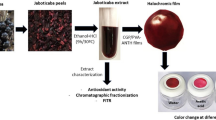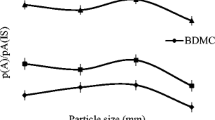Abstract
This study demonstrates a new Cellulose diacetate graft β-cyclodextrin (CDA-β-CD) copolymer asymmetric membrane prepared by a phase inversion technique for the separation of (−)-epigallocatechin-3-gallate (EGCG) from other polyphenols in crude tea. The graft copolymer, CDA-β-CD, was synthesized by prepolymerization of cellulose diacetate (CDA) and 1,6-hexamethylene-diisocyanate (HDI), which was then grafted with β-cyclodextrin (β-CD). Surface and crosssection morphologies of the CDA-β-CD membranes were analyzed by using scanning electron microscopy (SEM). Fourier transform infrared spectroscopy (FT-IR) indicated that the β-CD was grafted onto the CDA by chemical bonding. The influences of the HDI/CDA mass ratio and the catalyst mass fraction on the β-CD graft yield were investigated. The optimum conditions of a HDI/CDA mass ratio of 0.35 g·g−1 and a catalyst mass fraction of 0.18 wt-% produced a b-CD graft yield of 26.51 wt-%. The effects of the β-CD graft yield and the concentration of the polymer cast solution on the separation of EGCG were also investigated. Under optimum conditions of a β-CD graft yield of 24.21 wt-% and a polymer concentration of 13 wt-%, the purity of EGCG increased from 26.51 to 86.91 wt-%.
Similar content being viewed by others
References
Nagle D G, Ferreira D, Zhou Y D. Epigallocatechin-3-gallate (EGCG): chemical and biomedical perspectives. Phytochemistry, 2006, 67(17): 1849–1855
Xu J, Sandström C, Janson J C, Tan T. Chromatographic retention of epigallocatechin gallate on oligo-β-cyclodextrin coupled sepharose media investigated using NMR. Chromatographia, 2006, 64(1–2): 7–11
Xu J, Zhang G F, Tan T W, Janson J C. One-step purification of epigallocatechin gallate from crude green tea extracts by isocratic hydrogen bond adsorption chromatography on β-cyclodextrin substituted agarose gel media. Journal of Chromatography. B, Analytical Technologies in the Biomedical and Life Sciences, 2005, 824(1–2): 323–326
Kumamoto M, Sonda T, Takedomi K, Tabata M. Enhanced separation and elution of catechins in HPLC using mixed-solvents of water, acetonitrile and ethyl acetate as the mobile phase. Analytical Sciences, 2000, 16(2): 139–144
Amarowicz R, Maryniak A, Shahidi F. TLC separation of methylated (−)-epigallocatechin-3-gallate. Czech Journal of Food Sciences, 2005, 23: 36–39
Kim J I, Hong S B, Row K H. Effect of particle size in preparative reversed-phase high-performance liquid chromatography on the isolation of epigallocatechin gallate from Korean green tea. Journal of Chromatography. A, 2002, 949(1–2): 275–280
Sharma V, Gulati A, Ravindranath S D, Kumar V. A simple and convenient method for analysis of tea biochemicals by reverse phase HPLC. Journal of Food Composition and Analysis, 2005, 18(6): 583–594
Yanagida A, Shoji A, Shibusawa Y, Shindo H, Tagashira M, Ikeda M, Ito Y. Analytical separation of tea catechins and food-related polyphenols by high-speed counter-current chromatography. Journal of Chromatography. A, 2006, 1112(1–2): 195–201
Kartsova L A, Ganzha O V. Electrophoretic separation of tea flavanoids in the modes of capillary (zone) electrophoresis and micellar electrokinetic chromatography. Russian Journal of Applied Chemistry, 2006, 79(7): 1110–1114
Bazinet L, Labbe D, Tremblay A. Production of green tea EGC- and EGCG- enriched fractions by a two-step extraction procedure. Separation and Purification Technology, 2007, 56(1): 53–56
Chang C J, Chiu K L, Chen Y L, Chang C Y. Separation of catechins from green tea using carbon dioxide extraction. Food Chemistry, 2000, 68(1): 109–113
Wu X H. Application of membrane-separation in food technology. Food Research and Development, 2005, 26: 11–13 (in Chinese)
Kim H J, Tyagi R K, Fouda A E, Ionasson K. The kinetic study for asymmetric membrane formation via phase-inversion process. Journal of Applied Polymer Science, 1996, 62(4): 621–629
Wilbert M C, Pellegrino J, Zydney A. Bench-scale testing of surfactant-modified reverse osmosis/nanofiltration membranes. Desalination, 1998, 115(1): 15–32
Sivakumar M, Malaisamy R, Sajitha C J, Mohan D, Mohan V, Rangarajan R. Ultrafiltration application of cellulose acetate-polyurethane blend membranes. European Polymer Journal, 1999, 35(9): 1647–1651
Kozlowski C A, Sliwa W. The use of membranes with cyclodextrin units in separation processes: Recent advances. Carbohydrate Polymers, 2008, 74(1): 1–9
Schneiderman E, Stalcup A M. Cyclodextrins: a versatile tool in separation science. J Chromatography B. Biomedical Science Application, 2000, 745(1): 83–102
Tan Y, Hu A, Xia L, You T, Cao J. Synthesis and application of CDA-beta-CD in controlling release of drug. Journal of Applied Polymer Science, 2009, 113(3): 1811–1815
Lee J W, Hua F J, Lee D S. Thermoreversible gelation of biodegradable poly(ɛ-caprolactone) and poly(ethylene glycol) multiblock copolymers in aqueous solutions. Journal of Controlled Release, 2001, 73(2–3): 315–327
Pan X, Niu G, Liu H. Microwave-assisted extraction of tea polyphenols and tea caffeine from green tea leaves. Chemical Engineering and Processing, 2003, 42(2): 129–133
Richter R, Muller H P U S. Patent, 5045226, 1991-09-03
Ishizu T, Hirata C, Yamamoto H, Harano K. Structure and intramolecular flexibility of β-cyclodextrin complex with (−)-epigallocatechin gallate in aqueous solvent. Magnetic Resonance in Chemistry, 2006, 44(8): 776–783
Ismail A F, Hassan A R. Effect of additive contents on the performances and structural properties of asymmetric polyethersulfone (PES) nanofiltration membranes. Separation and Purification Technology, 2007, 55(1): 98–109
Strathmann H, Kock K, Amar P, Baker R W. The formation mechanism of asymmetric membranes. Desalination, 1975, 16(2): 179–203
Author information
Authors and Affiliations
Corresponding author
Rights and permissions
About this article
Cite this article
Zhu, H., Qin, P. Separation of epigallocatechin-3-gallate from crude tea polyphenols by using Cellulose diacetate graft β-cyclodextrin copolymer asymmetric membrane. Front. Chem. Sci. Eng. 5, 330–338 (2011). https://doi.org/10.1007/s11705-010-1104-6
Received:
Accepted:
Published:
Issue Date:
DOI: https://doi.org/10.1007/s11705-010-1104-6




